Ijraset Journal For Research in Applied Science and Engineering Technology
- Home / Ijraset
- On This Page
- Abstract
- Introduction
- Conclusion
- References
- Copyright
Use of Waste Paper for Light Weight Ecofriendly Bricks
Authors: Ayushi Tiwari, Mayur Singi
DOI Link: https://doi.org/10.22214/ijraset.2023.54822
Certificate: View Certificate
Abstract
The price of the materials is the main factor in every building project. Untapped or underused resources in emerging nations must be located in order to be utilized in the building industry. Wastepaper is one such resource. Papercrete, a lightweight building material that meets many of the engineering requirements for construction, is created by mixing paper pulp with cement and sand. Papercrete provides benefits such as being inexpensive, economical, and environmentally benign. The engineering characteristics of papercrete blocks are manufactured and investigated in this study. It should be emphasized that under compression, papercrete steadily degrades in a ductile way; nonetheless, the relationship between compressive stress and compressive strain that is discussed in this paper has not previously been established by trustworthy research.
Introduction
I. INTRODUCTION
A. Bricks
A brick is building material used to make walls, pavements and other elements in masonry construction. Traditionally, the term brick referred to a unit composed of clay, but it is now used to denote any rectangular units laid in mortar. A brick can be composed of clay-bearing soil, sand, and lime, or concrete materials. Bricks are produced in numerous classes, types, materials, and sizes which vary with region and time period, and are produced in bulk quantities.
The bricks are obtained by moulding clay in rectangular blocks of uniform size and then by drying and burning these blocks. At places where stones are not easily available but if there is plenty of clay suitable for the manufacture of bricks, the bricks replace stone. The brick earth should contain the following: Silica, Alumina, Lime, Iron oxide, and Magnesia.
Engineering Classification of Bricks:
- Unburnt bricks: Unburnt bricks or sun-dried bricks belong to the types which are dehydrated through heat generated by the sun once the process of moulding is completed. These types of bricks are utilized for building the temporary and low-priced structures. It is recommended that these types of bricks are unfit for the areas uncovered to deep rainfall.
- Burnt Bricks: Burnt bricks are formed after blazing the brick-mould in the drying oven within the factory. These types of bricks are generally utilized for construction processes. Burnt Bricks are segregated into the following four categories:
- First class bricks: These bricks belong to table-moulded and contain customary shape. The bricks are parched in drying oven. The facades and edges of the bricks are sharp, square, flat and straight. These bricks maintain superior quality. The bricks are crack free. The brick contains least crushing strength of 7 N/mm2. This is used for the construction of superior work i.e. heavy foundation and structures.
- Second class brick: These bricks belong to ground-moulded and they are burnt in kilns. The facade of these bricks is uneven to some extent and shape is also somewhat unequal. These bricks may contain fine hair cracks and little distortion. The edgings of these bricks are sharp and homogeneous. These bricks are generally applied in the areas where brickwork is supported with a coat of plaster. The minimum crushing strength of second class brick should be 70 kg per sq.cm
- Third class bricks: These bricks belong to ground-moulded and are moulded in drying ovens. These bricks are not so hard and include rough surfaces with uneven and distorted edges. These bricks provide dull sound if set collectively. The bricks are useful for minor and temporary structures and at areas where rainfall is normal. The bricks are formed with light color and are comparatively soft.
B. Waste Paper
A new nature study estimates the world has 3.04 trillion trees. Almost 4 billion trees worldwide is cut down each year for making paper. The construction industry has been known as one of the largest consumers of non-renewable resources.
On the other hand, more wastepaper ends up in landfill or dump sites than those recycled. Most of the paper waste generated is burnt in our country. This paper creates pollution and is not even recycled.
Wastepaper is found mostly in institutional buildings (schools, colleges), commercial buildings (offices, cooperative stores etc).
According to the Environment Protection Agency (EPA), the Unites States recycles about 45% of discarded paper annually. This means that about 55% or 48 million tons of paper ends up in landfill sites while some are incinerated. Wastepaper reusing has not been able to match waste paper generation. Since the large demand has been placed on the construction industry, especially in the last decade due to increase in pollution which cause a chronic shortage of building resources, the civil engineers have been challenged to convert the industrial waste to useful building and construction materials. One exclusive recycle opportunity is using wastepaper as a construction material. Since the construction industry uses up a great amount of nonrenewable resources, therefore the potential function of wastepaper for producing a low cost and light weight composite brick for construction not only delivers the potential use of waste paper recycling but it will likewise bring down the demand pressure on global natural resources.
II. OBJECTIVES
The main objectives of this study are:
- To study many literatures review on various test of brick.
- To analyze the effect of material on the tolerance, hardness, impact test, soundness, colour, efflorescence water absorption test, crushing strength and fire test of brick by adding some percentage of waste in the Eco-Friendly bricks.
- To analyze the cost estimate of approximation of the brick.
- To compare the result of conventional brick and light weight brick.
III. METHODOLOGY
A. Material Used
1) Cement
In today’s construction world 53 grade Ordinary Portland Cement (OPC) is the main component of concrete. It is an economical, high-quality construction material used in construction projects worldwide. Cement is made by grinding together a mixture of limestone and clay, which is then heated at a temperature of 1,450°C. What results is a granular substance called "clinker," a combination of calcium, silicate, alumina and iron oxide. Cement is one of the binding materials in this project. The cement should comply with all the standard requirements.
A cement is a binder, a substance used for construction that sets hardens and adheres to other materials , binding them together. Cement is seldom used on its own, but rather to bind sand and gravel together. Cement is used with fine aggregate to produce mortar for masonry, or with sand and gravel aggregates to produce concrete.
Cements used in construction are usually inorganic, often lime based, and can be characterized as being either hydraulic or non-hydraulic, depending upon the ability of the cement to set in the presence of water.
Non-hydraulic cement will not set in wet conditions or under water; rather, it sets as it dries and reacts with CO2 in the air. It is resistant to attack by chemicals after setting.
Hydraulic cements set and become adhesive due to a chemical reaction between the dry ingredients and water. The chemical reaction results in mineral hydrates that are not very water-soluble and so are quite durable in water and safe from chemical attack. This allows setting in wet conditions or under water and further protects the hardened material from chemical attack. The chemical process for hydraulic cement found by ancient Romans used portland cement with added lime (calcium oxide).
Non-hydraulic cement, such as slaked lime (calcium oxide mixed with water), hardens by carbonation in the presence of CO2 which is naturally present in the air. First calcium oxide (lime) is produced from calcim carbonate (limestone or chalk) by calcinations at temperatures above 825 °C (1,517 °F) for about 10 hours at atmospheric pressure.
CaCO3 → CaO + CO2
The calcium oxide is then spent (slaked) mixing it with water to make slaked lime (calcium hydroxide):
CaO + H2O → Ca(OH)2
Once the excess water is completely evaporated (this process is technically called setting), the carbonation starts:
Ca(OH)2 + CO2 → CaCO3 + H2O
This reaction takes a significant amount of time because the partial pressure of carbon dioxide in the air is low. The carbonation reaction requires the dry cement to be exposed to air, and for this reason the slaked lime is a non-hydraulic cement and cannot be used under water. This whole process is called the lime cycle.
a. Ordinary Portland Cement (OPC)
Ordinary Portland cement is the most widely used type of cement which is suitable for all general concrete construction. It is most widely produced and used type of cement around the world with annual global production of around 3.8 million cubic meters per year. This cement is suitable for all type of concrete construction.
b. Portland Pozzolana Cement (PPC)
Portland pozzolana cement is prepared by grinding pozzolanic clinker with Portland cement. It is also produced by adding pozzolana with the addition of gypsum or calcium sulfate or by intimately and uniformly blending portland cement and fine pozzolana.This cement has high resistance to various chemical attacks on concrete compared with ordinary portland cement and thus it is widely used. It is used in marine structures, sewage works, sewage works and for laying concrete under water such as bridges, piers, dams and mass concrete works etc
c. Rapid Hardening Cement
Rapid hardening cement attains high strength in early days it is used in concrete where formworks are removed at an early stage and is similar to ordinary portland cement (OPC). This cement has increased lime content and contains higher c3s content and finer grinding which gives greater strength development than OPC at an early stage.
The strength of rapid hardening cement at the 3 days is similar to 7 days strength of OPC with the same water-cement ratio. Thus, advantage of this cement is that formwork can be removed earlier which increases the rate of construction and decreases cost of construction by saving formwork cost.Rapid hardening cement is used in prefabricated concrete construction, road works, etc.
d. Quick setting cement
The difference between the quick setting cement and rapid hardening cement is that quick setting cement sets earlier while rate of gain of strength is like Ordinary Portland Cement, while rapid hardening cement gains strength quickly. Formworks in both cases can be removed earlier.Quick setting cement is used where works is to be completed in very short period and for concreting in static or running water.
e. Low Heat Cement
Low heat cement is prepared by maintaining the percentage of tricalcium aluminate below 6% by increasing the proportion of C2S. This makes the concrete to produce low heat of hydration and thus is used in mass concrete construction like gravity dams, as the low heat of hydration prevents the cracking of concrete due to heat. This cement has increased power against sulphates and is less reactive and initial setting time is greater than OPC.
f. Sulphates Resisting Cement
Sulfate resisting cement is used to reduce the risk of sulphate attack on concrete and thus is used in construction of foundations where soil has high sulphate content. This cement has reduced contents of C3A and C4AF.Sulfate resisting cement is used in construction exposed to severe sulphate action by water and soil in places like canals linings, culverts, retaining walls, siphons etc.
g. Blast Furnace Slag Cement
Blast furnace slag cement is obtained by grinding the clinkers with about 60% slag and resembles more or less in properties of Portland cement. It can be used for works economic considerations is predominant.
h. High Alumina Cement
High alumina cement is obtained by melting mixture of bauxite and lime and grinding with the clinker. It is a rapid hardening cement with initial and final setting time of about 3.5 and 5 hours respectively. The compressive strength of this cement is very high and more workable than ordinary portland cement and is used in works where concrete is subjected to high temperatures, frost, and acidic action.
i. White Cement
It is prepared from raw materials free from Iron oxide and is a type of ordinary portland cement which is white in color. It is costlier and is used for architectural purposes such as precast curtain wall and facing panels, terrazzo surface etc.
and for interior and exterior decorative work like external renderings of buildings, facing slabs, floorings, ornamental concrete products, paths of gardens, swimming pools etc.
j. Colored cement
It is produced by mixing 5- 10% mineral pigments with ordinary cement. They are widely used for decorative works in floors.
k. Air Entraining Cement
Air entraining cement is produced by adding indigenous air entraining agents such as resins, glues, sodium salts of sulphates etc. during the grinding of clinker. This type of cement is especially suited to improve the workability with smaller water cement ratio and to improve frost resistance of concrete.
l. Expansive Cement
Expansive cement expands slightly with time and does not shrink during and after the time of hardening. This cement is mainly used for grouting anchor bolts and prestressed concrete ducts.
m. Hydrographic cement
Hydrographic cement is prepared by mixing water repelling chemicals and has high workability and strength. It has the property of repelling water and is unaffected during monsoon or rains. Hydrophobic cement is mainly used for the construction of water structures such dams, water tanks, spillways, water retaining structures etc.
Table 1 : Properties of cement
|
Description of test |
Results obtained |
Requirement of IS: 8112-1989 |
|
Specific gravity |
3.15 |
3.15 |
|
Initial setting time |
75 minutes |
Min. 30 minutes |
|
Final setting time. |
270 minutes |
Max. 600 minutes |
|
Fineness |
412.92 m2 /kg |
Min. 225 m2 /kg |
2) Sand
Sand particles consist of small grains of silica (SiO2). It is formed by the decay of sand stones due to various effects of weather. According to natural resources from which the sand is obtained, it is termed as pit sand, river sand and sea sand. Sand is used to provide bulk, strength, and other properties to construction materials like asphalt and concrete. It is also used as a decorative material in landscaping. Specific types of sand are used in the manufacture of glass and as a molding material for metal casting.
According to the size of grains, the sand is classified as fine, coarse and gravel.
a. Fineness of sand: Fineness modulus of sand (fine aggregate) is an index number which represents the mean size of the particles in sand. It is calculated by performing sieve analysis with standard sieves. The cumulative percentage retained on each sieve is added and subtracted by 100 gives the value of fine aggregate.Fine aggregate means the aggregate which passes through 4.75mm sieve. To find the fineness modulus of fine aggregate we need sieve sizes of 4.75mm, 2.36mm, 1.18mm, 0.6mm, 0.3mm and 0.15mm. Fineness modulus of finer aggregate is lower than fineness modulus of coarse aggregate.
b. Specific gravity of sand: The fine aggregate specific gravity test is used to calculate the specific gravity of a fine aggregate sample by determining the ratio of the weight of a given volume of aggregate to the weight of an equal volume of water. It is similar in nature to the coarse aggregate specific gravity test.
The properties were analyzed as per BIS standard.
Table 2: Properties of sand
|
Sr. no. |
Properties |
Results obtained |
|
1. |
Fineness |
4.40% |
|
2. |
Specific gravity |
2.60 |
3) Aggregates
These are the inert or chemically inactive materials which forms bulk of brick mortar. These aggregates are bound together by means of cement. Most of the volume of brick is born by the aggregates. They provide strength as well as proper shape to the bricks. The aggregates are classified into two categories: fine and coarse.
In this project we have used following materials as aggregates
a. Stone chippings retained on 4.75mm IS sieve.
b. Stone chippings passed on 4.75mm IS sieve.
c. Water
Water is an important ingredient of preparation of brick as it is involved in the chemical reaction with cement. Potable water should be used for both soaking and mixing. It should be free from organic matter.
4) Additives
Cement is added to the matrix as a binding material. In addition to that, waterproofing admixtures such as Dr. Fixit 101 LW+ is added to the mix for minimizing the percentage of water. Approximately 6ml to 8ml was used for 18 litres of pulp preparation.
5) Paper pulp
The papers, which were collected, cannot be utilized immediately. It should be made into a paper pulp before mixing with other ingredients. The papers were kept in the tank for 7 days, otherwise until the papers degrade into a paste-like form. Then the paper was taken out of the water and taken to the mixer machine to make it as a paper pulp. Paper pulp acts as base material for manufacturing of paper bricks. It is a major component used in preparation of brick.
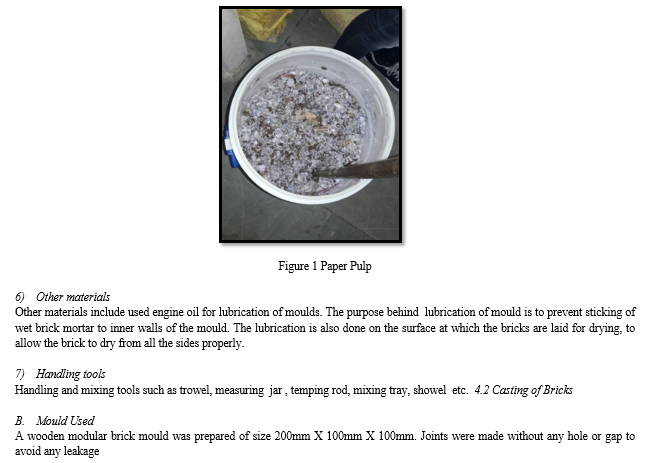
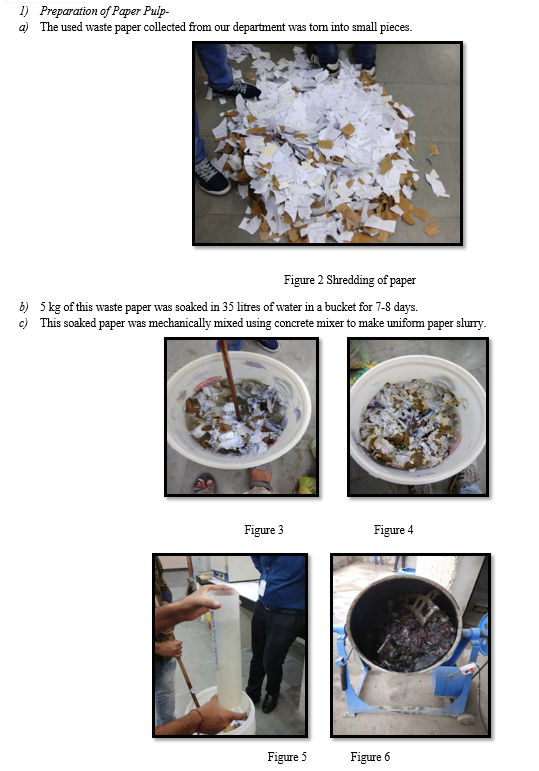

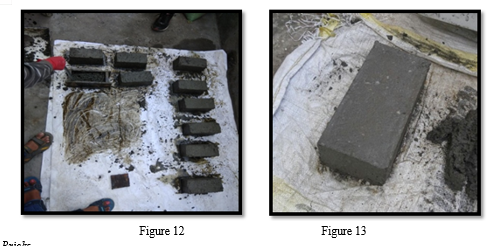
C. Test on Bricks
Various types of tests on bricks are conducted to check the qualities of bricks for construction purposes. Tests on bricks are conducted at construction site as well as in laboratory. Bricks are oldest and important construction materials because of their durability, reliability, strength and low cost. To produce good quality of structure, good quality materials are required. To decide the quality of the materials some tests are to be conducted on bricks
1. Test for Bricks
A conventional brick is generally subjected to the following tests to find for the construction work,
a. Dimension & Tolerance:
In this test, a brick is closely inspected. It should be of standard size and its shape should be truly rectangular with sharp edges. For this purpose, 20 bricks of standard size (190 mm x 90 mm x 90 mm) are selected at random and they are stacked lengthwise, along the width and along the height.
For good quality bricks, the results should be within the following permissible limits
b. Hardness test on bricks:
In this test, a scratch is made on brick surface with the help of a finger nail. If no impression is left on the surface, the brick is sufficiently hard.
c. Impact test
In this test bricks are allowed to fall from a height of 1 metre. If bricks break then it has low impact value and is not suitable for construction. Good quality bricks do not break after falling.
d. Soundness test on brick
In this test, the two bricks are taken and they are struck with each other. The bricks should not break and a clear metallic sound should be produced. It is a field test. It quickly gives an idea about the quality of brick.
e. Colour
A good brick should possess bright and uniform color throughout its body. Conventional brick should posses reddish brown . However it may depend on its ingredients.
f. Presence Of Soluble Salts
The soluble salts, if present in cause efflorescence in brick work. For finding out the presence of soluble salts in a brick, it is immersed in water for 24 hours. It is then taken out and allowed to dry in shade. The absence of grey or white deposits on indicates absence of soluble salts.
If the white deposits cover about 10 per cent surface, the efflorescence is said to be slight and it is considered as moderate, when the white deposits cover about 50 per cent of surface. If grey or white deposits are found on more than 50 per cent of surface, the efflorescence becomes heavy and it is treated as serious, when such deposits are converted into powdery mass.
g. Absorption
A brick is taken and it is weighed dry. It is then immersed in water for a period of 16 hours. It is weighed again and the difference in weight indicates the amount of water absorbed by the brick. It should not in exceed 20 per cent of weight of dry brick
The degree of compactness of bricks can be obtained by water absorption test, as water is absorbed by pores in bricks. The water absorption by bricks increase with increase in pores.
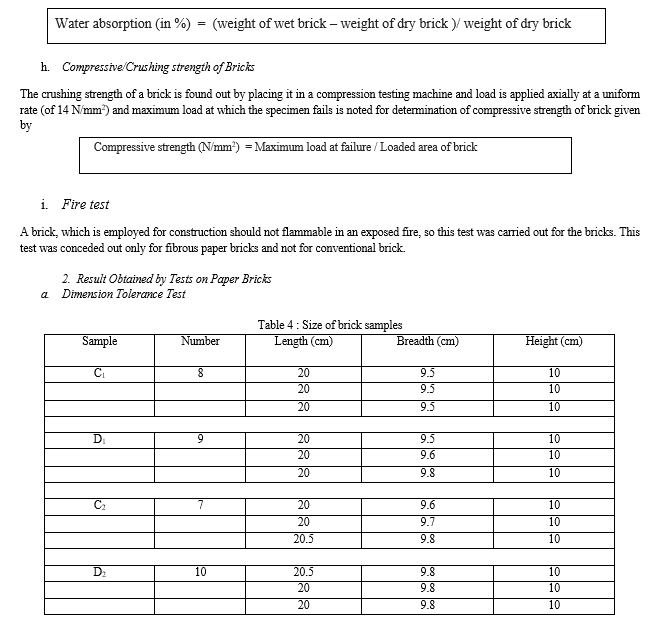


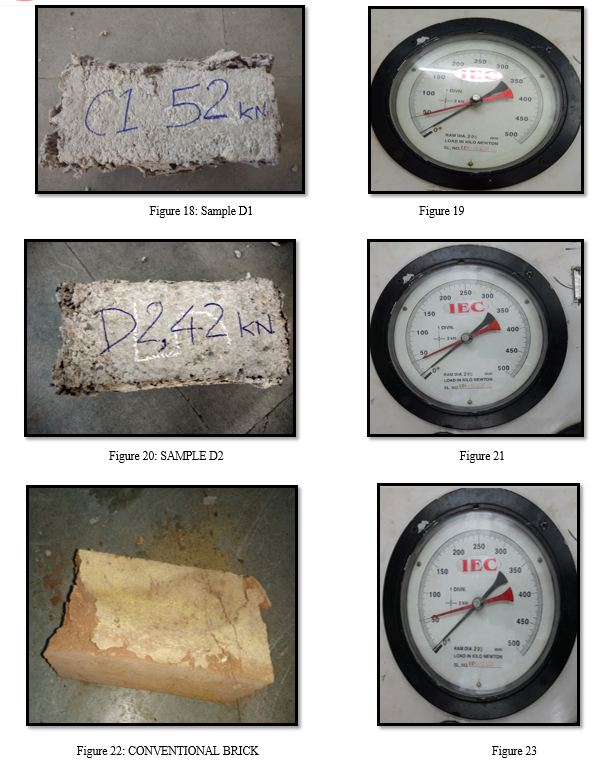
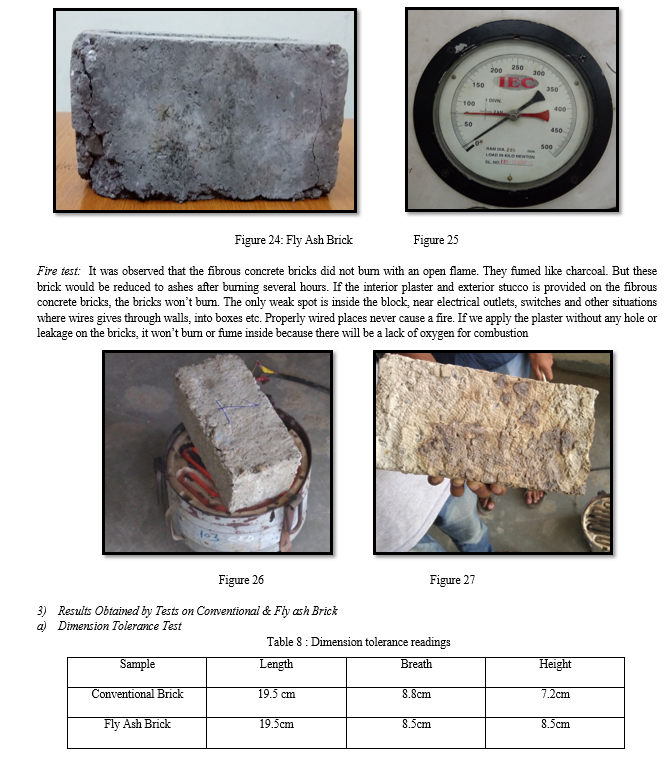
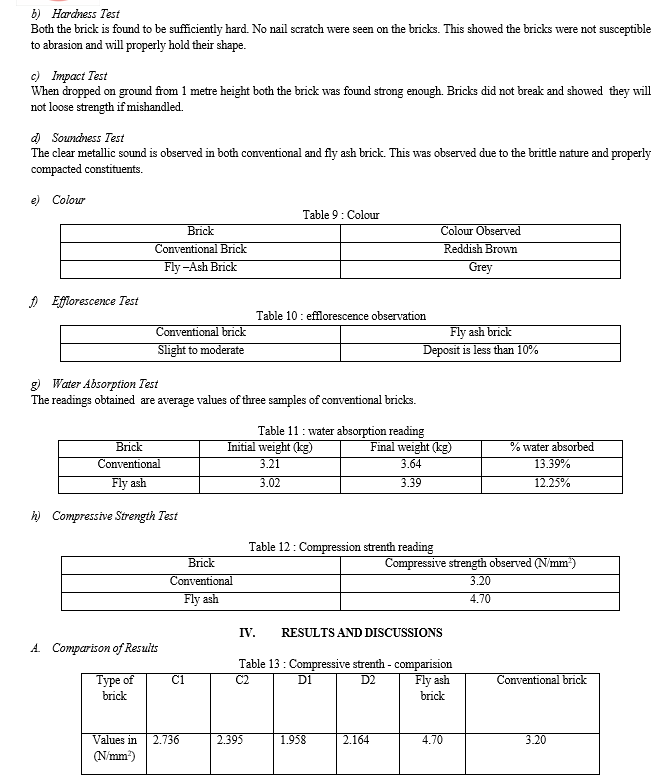
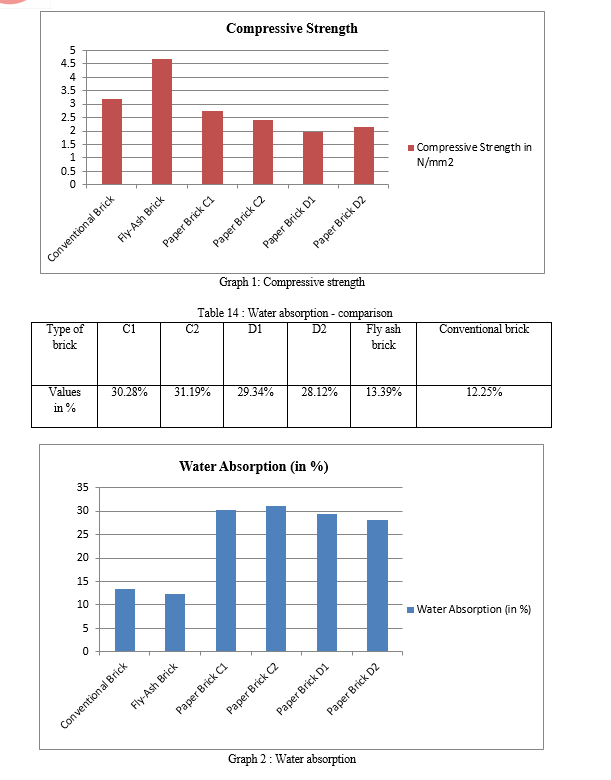
B. Discussions
- We have successfully decreased water absorption of bricks by 3% to 7%. This was due to proper machine mixing and compaction. Currently it was observed that water absorption of brick was found to be about 24%.
- According to classification of bricks, these paper bricks fall in class C.
- Change of dimensions to conventional brick dimensions prevented the bricks from piercing out in compression testing machine (CTM).
- The paper bricks showed successful results in impact test and hardness test on comparison with conventional bricks.
- As the results of dimension tolerance test showed, the paper bricks were of uniform and definite shape and size.
- The paper bricks showed successful results in fire test as they did not burn with flame.
- The paper bricks showed positive results in soundness test and efflorescence test.
- Compressive strength of bricks were significantly improved. However there is enough scope of research and improvement in both the aspects i.e. water absorption and compressive strength.
- We also tried dipping some samples of paper brick in water cement slurry which gave satisfactory results by decreasing water absorption further by 1.5 to 2.5 % further.
Conclusion
1) Considering the desirable compressive strength shown by the tested sample, it is clear that the paper brick have ability to provide ecofriendly light weight brick with the use of fewer natural resources. Though the results obtained during compression test showed that these bricks are mostly acceptable for non load bearing walls only. 2) As per research the brick should not absorb water more than 20%. The water absorption of paper brick was found to be more than 20%, which makes it not suitable for water logging and external walls. However, by providing water proof coating (silicon based water proofing) It can be used in case of external walls also. 3) The weight of paper brick was lesser than conventional brick and fly ash bricks. This causes the dead load of building to reduce considerably. 4) Due to lesser weight and more flexibility, these bricks can be potentially used for construction of building in earthquake prone areas. 5) These bricks do not expand nor shrinks hence, sheets of glass or glass block can be fixed in and trimmed with paper brick. 6) Since in compression test the failure of paper brick was found to be non brittle some more research for brick mortar to make paper brick brittle and water proof. 7) The paper pulp used for mortar can be obtained from paper industry where it is dumped in landfills. This makes the brick environment friendly and efficient in reuse of waste. 8) This bricks have good sound absorbent, good thermal resistance. In walls 12 to 16 inches thick, the energy saving of papercrete will be a great advantage for the house owner and environment. 9) Another of the advantages of adding waste to the brick prototypes is that they provide energy due to their organic material content. This could help to reduce fuel consumption and kiln time required for brick production.
References
[1] International Journal of Science and Research (IJSR) - Rohit Kumar Arya1 , Rajeev Kansal2 1 PG Student, Construction Technology & Management, Madhav Institute of Technology and Science, Gwalior, Madhya Pradesh [2] Study of Concrete Involving Use of Waste Paper Sludge Ash as Partial Replacement of Cement - Sajad Ahmad, M. Iqbal Malik, Muzaffar Bashir Wani, Rafiq Ahmad [3] Papercrete Bricks - An Alternative Sustainable Building Material - *Assistant Professor, Dept. of Civil Engineering, Maharaja Institute of Technology Mysore, Mandya-38 [4] Utilization of Waste Paper Sludge in Construction Industry – Sandeep Jain IIT Delhi [5] The Use of Waste Materials in the Construction Industry - Ryszard Dachowski, Parlina Kostrzewa WMCAUS 2016. [6] Lab manual for material testing by C. B. Kukreja. [7] Building materials by S C Rangwala. [8] https://en.wikipedia.org/wiki/Cement [9] https://www.theconstructioncivil.org/test-for-bricks
Copyright
Copyright © 2023 Ayushi Tiwari, Mayur Singi. This is an open access article distributed under the Creative Commons Attribution License, which permits unrestricted use, distribution, and reproduction in any medium, provided the original work is properly cited.

Download Paper
Paper Id : IJRASET54822
Publish Date : 2023-07-17
ISSN : 2321-9653
Publisher Name : IJRASET
DOI Link : Click Here
 Submit Paper Online
Submit Paper Online

